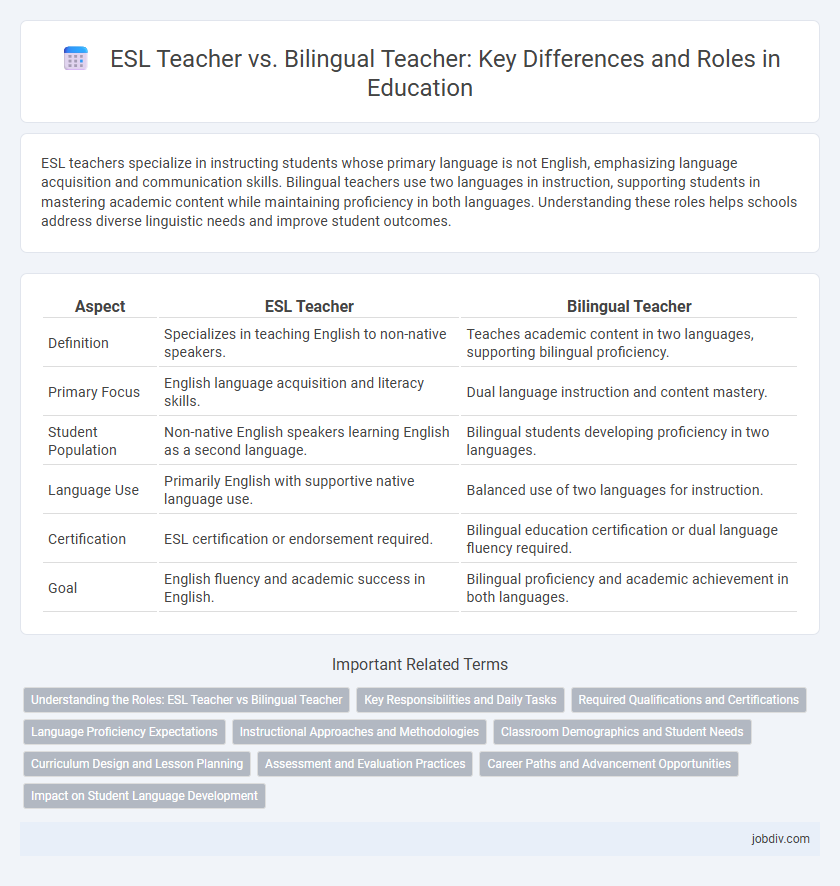ESL teachers specialize in instructing students whose primary language is not English, emphasizing language acquisition and communication skills. Bilingual teachers use two languages in instruction, supporting students in mastering academic content while maintaining proficiency in both languages. Understanding these roles helps schools address diverse linguistic needs and improve student outcomes.
Table of Comparison
| Aspect | ESL Teacher | Bilingual Teacher |
|---|---|---|
| Definition | Specializes in teaching English to non-native speakers. | Teaches academic content in two languages, supporting bilingual proficiency. |
| Primary Focus | English language acquisition and literacy skills. | Dual language instruction and content mastery. |
| Student Population | Non-native English speakers learning English as a second language. | Bilingual students developing proficiency in two languages. |
| Language Use | Primarily English with supportive native language use. | Balanced use of two languages for instruction. |
| Certification | ESL certification or endorsement required. | Bilingual education certification or dual language fluency required. |
| Goal | English fluency and academic success in English. | Bilingual proficiency and academic achievement in both languages. |
Understanding the Roles: ESL Teacher vs Bilingual Teacher
ESL teachers specialize in instructing students whose primary language is not English, focusing on developing proficiency in reading, writing, speaking, and listening skills within an English-only classroom environment. Bilingual teachers provide instruction in both English and the students' native language, facilitating content comprehension while supporting language development across subjects. Understanding these roles highlights the distinction between language acquisition support (ESL) and dual-language instruction aimed at maintaining cultural and linguistic identity (bilingual).
Key Responsibilities and Daily Tasks
ESL teachers specialize in developing English language proficiency for non-native speakers through lessons on grammar, vocabulary, and pronunciation, with key responsibilities including designing targeted language activities and assessing student progress in English fluency. Bilingual teachers deliver instruction in two languages to support both academic content and language development, managing tasks such as translating lessons, facilitating communication for diverse learners, and promoting cultural understanding. Both roles require adapting teaching strategies to meet students' linguistic needs but differ in the scope of language instruction and integration within the classroom environment.
Required Qualifications and Certifications
ESL teachers typically require a bachelor's degree in education or linguistics along with a TEFL, TESOL, or CELTA certification to effectively teach English as a second language. Bilingual teachers must have similar degrees but also demonstrate proficiency in two languages, often needing state-specific bilingual certification or endorsement. Both roles benefit from coursework in second language acquisition, cultural competency, and specialized teaching methods tailored to language learners.
Language Proficiency Expectations
ESL teachers are expected to have native or near-native proficiency in English to effectively support English language learners in mastering academic language skills. Bilingual teachers must demonstrate fluency in both English and a second language, enabling them to deliver instruction and support literacy development in two languages simultaneously. Language proficiency standards for bilingual educators often require certification or assessment in both languages to ensure balanced bilingualism for diverse student populations.
Instructional Approaches and Methodologies
ESL teachers utilize specialized instructional approaches such as sheltered instruction and communicative language teaching to support English language learners in developing proficiency across listening, speaking, reading, and writing skills. Bilingual teachers employ methodologies like dual-language immersion and translanguaging that leverage students' native languages alongside English to enhance cognitive development and academic achievement in both languages. Both roles emphasize differentiated instruction tailored to students' language proficiency levels and cultural backgrounds for effective learning outcomes.
Classroom Demographics and Student Needs
ESL teachers primarily support students learning English as a second language, often in classrooms with diverse linguistic backgrounds requiring focused language acquisition strategies. Bilingual teachers instruct students in two languages, addressing the needs of learners who are developing literacy and academic skills in both their native language and English. Classroom demographics influence instructional methods, with ESL teachers emphasizing intensive language development, while bilingual teachers balance dual language proficiency to meet diverse student needs.
Curriculum Design and Lesson Planning
ESL teachers specialize in designing curriculum and lesson plans that target language acquisition for non-native English speakers, emphasizing grammar, vocabulary, and conversational skills. Bilingual teachers tailor their instructional materials to support content learning in two languages, ensuring students develop proficiency across subjects while maintaining their native language. Effective lesson planning for both roles involves integrating cultural relevance and differentiated strategies to promote language development and academic achievement.
Assessment and Evaluation Practices
ESL teachers primarily utilize language proficiency assessments such as the WIDA ACCESS and CELDT to evaluate students' English language development, focusing on listening, speaking, reading, and writing skills. Bilingual teachers incorporate both language proficiency tests and subject-specific evaluations in the students' native and English languages, enabling comprehensive assessment of academic content understanding alongside language acquisition. Effective evaluation practices in bilingual education emphasize differentiated assessments that support dual language growth and academic achievement.
Career Paths and Advancement Opportunities
ESL teachers specialize in English language instruction for non-native speakers, often advancing to roles such as curriculum developers, language coordinators, or ESL program directors. Bilingual teachers deliver instruction in two languages, opening career paths in dual language program leadership, multicultural education administration, or specialized instructional coaching. Both career tracks offer opportunities for higher education roles and district-level educational policy positions focused on language acquisition and cultural competence.
Impact on Student Language Development
ESL teachers specialize in helping non-native speakers acquire English proficiency, accelerating language acquisition through targeted instruction in grammar, vocabulary, and pronunciation. Bilingual teachers support students by teaching content in both their native language and English, fostering cognitive development and preserving cultural identity while promoting bilingualism. Research indicates bilingual instruction enhances overall academic achievement and linguistic flexibility, benefiting long-term communication skills.
ESL Teacher vs Bilingual Teacher Infographic

 jobdiv.com
jobdiv.com